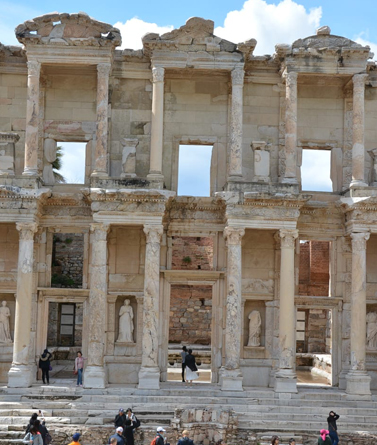According to archeological foundations, Ephesus city was founded by the Amazon ladies and later on (3000 BC), and then it was inhabited by Hittities, Carians and the Lelegians.
The name of the first city was APASAS. Even though there is no safe conclusion regarding its foundation and the exact date of it, Ephesus have been placed in 2,000 BC, as a city which was located close to the temple dedicated to the goddess of fertility, Cybele.
The location of Ephesus is considered to be advantageous thanks to its climate which offered that area fertility.
The first settlements of Ephesus were made by the Ionians in the 11th century BC, when Androcles (son of Condros from who was the King Of Ionia ), founded a town which was located 1.5 kilometers away from Artemis’s Temple.
According to legend, he had been advised to establish a city at the place which would be shown to him by a fish and a wild boar. During the time of Androcles’s, Ephesus became a member of the Ionian League. Also his descendants ruled the city for a long period.
As years passed, Ephesus grew to a prosperous city and it was turned to a trade and banking centre which was ruled by rich merchants. This attracted the interest of the king of Lydia, Kroisos, with whom Ephesus had already commercial relations. Lydians conquered Ephesus and made the habitants to the inland close to the Temple of Artemis. The Lydians ruled Ephesus until the Persian Wars when the Persians took it over.
However, Alexander the Great set the city free in 334 BC and after his death it was ruled by Lysimachus, a descendant of Alexander the Great.
As the city was located by the river Kaystros (nowadays known as Kucuk Menderes river) which cut off the outlet to the sea with alluvial sand, it created a marshy earth which in turn created an unhealthy environment for the population of Ephesus. Lysimachus decided to transfer the city to the valley situated between the mountains Koressos and Pion (nowadays known as Bulbul and Payir). He also fortified the city with a wall 9 km long. He named the new city after his wife, Arsinoe. The city grew again in a rich trade centre and several public buildings such as stadiums, gymnasiums, theatres etc were erected in it.
After Lysimachus’s death, the city was ruled by the Egyptians and the Syrians and it was conquered by the Romans in 190 BC. Ephesus was ruled by the Romans indirectly, through Pergamum and started blooming during the Augustan Empire era. It became the capital of the Asian province of the Roman Empire and it grew to the most important trading centre of Minor Asia, inhabited by 250,000 people. Most of the monuments, that have survived nowadays, date pack to the prosperous period.
The Goths invaded the city in 263 Ad and they destroyed both the city and the temple of Artemis. Ephesus declined since then and even though it was rebuilt, it never regained its old splendor.
During the Byzantine era, Ephesus was a very important city (5th-6th centuries AD). A big part of the city was rebuilt by Constantine I. In 614 AD the city was destroyed again due to an earthquake. Continuously, the harbor of the city turned to a marshy are once preventing the inhabitants from accessing the sea and carry on their trading activities. The harbor decline and the Arabic invasions made the population to move towards a hill where they would be protected. As they had no more a connection with the sea, the city declined and it was turned to a small village, occupied by the Turks in 1390.
Finally, the city was abandoned during the 15th century as there was no possibility to regain its past.

